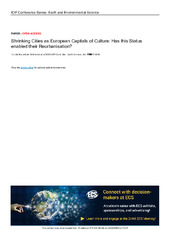Приказ основних података о документу
Shrinking Cities as European Capitals of Culture: Has this Status enabled their Reurbanisation?
| dc.creator | Antonić, Branislav | |
| dc.creator | Djukić, Aleksandra | |
| dc.creator | Marić, Jelena | |
| dc.date.accessioned | 2023-07-03T10:19:03Z | |
| dc.date.available | 2023-07-03T10:19:03Z | |
| dc.date.issued | 2023 | |
| dc.identifier.uri | https://raf.arh.bg.ac.rs/handle/123456789/1290 | |
| dc.description.abstract | More than 50 cities across Europe have been designed as the European capitals of culture for one year since the launch of this programme in 1985. Through organisation of different cultural events, this programme gives selected cities accessibility to generate significant cultural and socio-economic advantages, addressing their long-term regeneration and revitalisation and better competitiveness thereof. Several selected cities had gained this status during long-term urban shrinkage, the process where a population loss is caused by local socio-economic difficulties. Therefore, the supreme goal of such cities is certainly the reurbanisation based on better economic performance. The goal of the programme of European capital of culture –culture-led regeneration and revitalisation – perfectly fits with solutions for the economic problems of shrinking cities. The aim of this paper is to analyse has the status of European capital of culture has had an impact on population trends in the selected shrinking cities. Before the analysis, theoretical link between the concept of shrinking cities and urban regeneration and revitalisation is made. The selected cases are the shrinking cities with this status from 1985-2017, to preserve a 5-year threshold, adequate for the most recent demographic trends. The obtained results from the analysis show that the majority of the selected cities have entered reurbanisation after their year of the European capital of culture. Nevertheless, some of them have continued to shrink. The obtained results of the reurbanisation or prolonged shrinkage of the cities are further combined with the other characteristics of the selected cities, to fully understand their context. Comparing this, the paper conclusions target to indicate if and how the status of European capital of culture impacts on the local economy of a selected city though culture-led urban regeneration and revitalisation. | sr |
| dc.language.iso | en | sr |
| dc.publisher | IOP Publishing | sr |
| dc.relation | DANUrB+ | sr |
| dc.rights | openAccess | sr |
| dc.rights.uri | https://creativecommons.org/licenses/by/4.0/ | |
| dc.source | SBE23 Proceedings "Sustainable built environments: Paving the way for achieving the targets of 2030 and beyond" | sr |
| dc.subject | Shrinking cities | sr |
| dc.subject | European capital of culture | sr |
| dc.subject | Urban regeneration | sr |
| dc.subject | Reurbanisation | sr |
| dc.subject | Culture-led economy | sr |
| dc.title | Shrinking Cities as European Capitals of Culture: Has this Status enabled their Reurbanisation? | sr |
| dc.type | conferenceObject | sr |
| dc.rights.license | BY | sr |
| dcterms.abstract | Дјукић, Aлександра; Марић, Јелена; Aнтонић, Бранислав; | |
| dc.rights.holder | IOP Conference Series | sr |
| dc.citation.issue | 1196 | |
| dc.citation.spage | 012095 | |
| dc.identifier.doi | 10.1088/1755-1315/1196/1/012095 | |
| dc.identifier.fulltext | http://raf.arh.bg.ac.rs/bitstream/id/4449/bitstream_4449.pdf | |
| dc.type.version | publishedVersion | sr |

